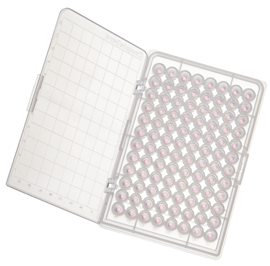
Biomatrica Dry Storage Device DNA Stability Studies
Participants: Margaret C. Kline
Project Timeframe: June 2007 to present
Purpose: The ability to ship and store DNA samples at room temperature could benefit laboratories This particular study has been designed to examine the effect of “shipping” well characterized genomic DNA extracts on Biomatrica SampleGard™ Dry Storage Devices.
Progress: The devices (three replicate plates) have been prepared at NIST with 20 µL of genomic DNA at concentrations of 1 ng/µL, 0.25 ng/µL and 0.05 ng/µL. NIST plans to analyze the selected genomic DNA extract before and after application on the storage device using appropriate DNA quantitation assay(s) such as Quantifiler and short tandem repeat (STR) genotyping methods such as Identifiler. Two plates are being shipped at ambient temperature back and forth multiple times between Maryland (NIST) and California (Biomatrica) in the middle of the summer via U.S. Postal Service in Barrier pouches supplied by Biomatrica. Two portable temperature/humidity recorders are being shipped along side the plates to enable monitoring environmental conditions. Sampling is being conducted at NIST with each arrival of the shipped plates and compared to a control plate stored at NIST for the duration of the study. The range of temperature and humidity changes experienced by the shipped samples will be tracked. The shipping and analysis process will be repeated until degradation of the samples is detected or the samples have been exhausted. Starting this study during the summer months is desirable to stress the system at extreme heat and humidity conditions commonly occurring during the shipping process.
Publications or Presentations Resulting From This Project:
[Return to NIJ Projects page] [Return to STRBase]
Last updated: 07/02/2007
Disclaimer: This project was supported by National Institute of Justice Grant Number 2003-IJ-R-029, which is an interagency agreement between NIJ and the NIST Office of Law Enforcement Standards, awarded by the National Institute of Justice, Office of Justice Programs, US Department of Justice. Points of view in this document are those of the authors and do not necessarily represent the official position or policies of the US Department of Justice. Certain commercial equipment, instruments and materials are identified in order to specify experimental procedures as completely as possible. In no case does such identification imply a recommendation or endorsement by the National Institute of Standards and Technology nor does it imply that any of the materials, instruments or equipment identified are necessarily the best available for the purpose.